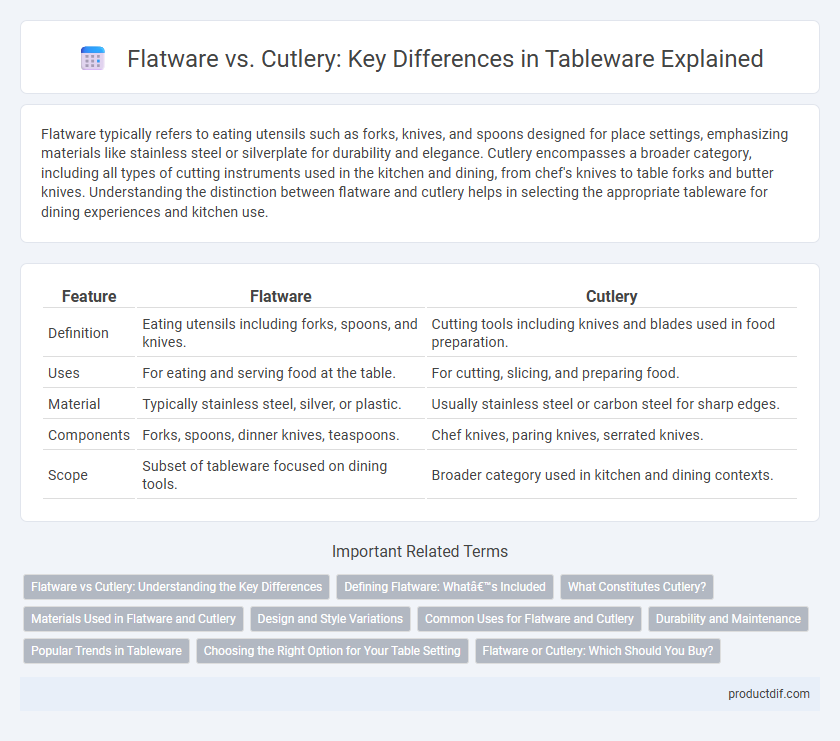Flatware typically refers to eating utensils such as forks, knives, and spoons designed for place settings, emphasizing materials like stainless steel or silverplate for durability and elegance. Cutlery encompasses a broader category, including all types of cutting instruments used in the kitchen and dining, from chef's knives to table forks and butter knives. Understanding the distinction between flatware and cutlery helps in selecting the appropriate tableware for dining experiences and kitchen use.
Table of Comparison
| Feature | Flatware | Cutlery |
|---|---|---|
| Definition | Eating utensils including forks, spoons, and knives. | Cutting tools including knives and blades used in food preparation. |
| Uses | For eating and serving food at the table. | For cutting, slicing, and preparing food. |
| Material | Typically stainless steel, silver, or plastic. | Usually stainless steel or carbon steel for sharp edges. |
| Components | Forks, spoons, dinner knives, teaspoons. | Chef knives, paring knives, serrated knives. |
| Scope | Subset of tableware focused on dining tools. | Broader category used in kitchen and dining contexts. |
Flatware vs Cutlery: Understanding the Key Differences
Flatware primarily refers to eating utensils such as forks, knives, and spoons used at the dining table, often made from stainless steel or silver. Cutlery encompasses all cutting tools, including knives used in both kitchen preparation and dining, along with forks and spoons. Understanding the distinction between flatware and cutlery helps in selecting appropriate tableware for specific culinary needs and settings.
Defining Flatware: What’s Included
Flatware primarily refers to eating utensils such as forks, knives, and spoons designed for individual use during meals, often made from stainless steel or silver. It excludes kitchen tools and serving instruments, which are categorized separately under cutlery. Understanding the specific components of flatware helps in selecting appropriate dining sets and complements broader tableware collections.
What Constitutes Cutlery?
Cutlery refers to all hand-held utensils used for eating, serving, and preparing food, including knives, forks, and spoons. Unlike flatware, which primarily emphasizes forks, knives, and spoons for dining, cutlery encompasses a broader range of specialized tools such as carving knives, butter knives, and seafood forks. Materials commonly used in cutlery include stainless steel, silver, and sometimes titanium, ensuring durability and corrosion resistance.
Materials Used in Flatware and Cutlery
Flatware is commonly made from stainless steel, which offers durability, corrosion resistance, and ease of maintenance, making it ideal for everyday use. Cutlery often features materials such as high-carbon steel, ceramic, and Damascus steel to ensure sharpness, precision cutting, and aesthetic appeal, especially in knives. While both flatware and cutlery prioritize functional materials, flatware emphasizes corrosion resistance and comfort, whereas cutlery focuses more on blade hardness and edge retention.
Design and Style Variations
Flatware and cutlery differ primarily in design and style variations, with flatware encompassing forks, knives, and spoons used for dining, often featuring sleek, modern aesthetics or ornate, traditional patterns. Cutlery typically refers to cutting tools, including knives designed with ergonomic handles and diverse blade shapes to enhance functionality and visual appeal. Style variations range from minimalist stainless steel to intricate vintage designs, catering to both contemporary and classic table settings.
Common Uses for Flatware and Cutlery
Flatware commonly includes forks, knives, and spoons used primarily for eating and serving food at the dining table, such as dinner forks, salad forks, and teaspoons. Cutlery refers broadly to cutting instruments like kitchen knives, steak knives, and carving sets designed for food preparation and precise cutting tasks. While flatware emphasizes table use, cutlery extends to both preparation and consumption activities in culinary settings.
Durability and Maintenance
Flatware, typically made from stainless steel, offers superior durability and resists rust, making it ideal for daily use and frequent washing. Cutlery, often incorporating sharper blades and more varied materials like carbon steel or ceramic, demands careful maintenance to prevent dullness and corrosion. Proper cleaning and storage are essential to preserve the longevity of both flatware and cutlery, enhancing performance and aesthetic appeal over time.
Popular Trends in Tableware
Flatware, typically referring to forks, knives, and spoons made from stainless steel or silver, remains a staple in modern tableware collections, with matte finishes and minimalist designs gaining significant popularity. Cutlery, often encompassing a broader range of knives including specialty blades for cooking and dining, has seen a rise in demand for ergonomic handles and sustainable materials like bamboo and recycled metals. Popular trends highlight the fusion of functionality and aesthetics, with mixed metal sets combining gold, copper, and silver tones to create visually striking tablescapes.
Choosing the Right Option for Your Table Setting
Flatware generally refers to eating utensils such as forks, knives, and spoons designed for everyday use, while cutlery often includes cutting implements like steak knives alongside standard utensils. Choosing the right option depends on your table setting style, meal type, and aesthetic preferences, where flatware suits casual and functional settings, and cutlery enhances formal or specialized dining experiences. Selecting materials such as stainless steel for durability or silver for elegance further customizes the table arrangement to fit the occasion and maintenance needs.
Flatware or Cutlery: Which Should You Buy?
Flatware typically refers to eating utensils such as forks, knives, and spoons used at the dining table, while cutlery often includes both flatware and other cutting instruments like kitchen knives. Choosing between flatware and cutlery depends on your needs; flatware is essential for everyday meals and formal dining settings, whereas cutlery offers a broader range for food preparation and serving. Investing in high-quality flatware made from stainless steel or silver-plated materials ensures durability, ease of maintenance, and an elegant table presentation.
Flatware vs Cutlery Infographic

 productdif.com
productdif.com